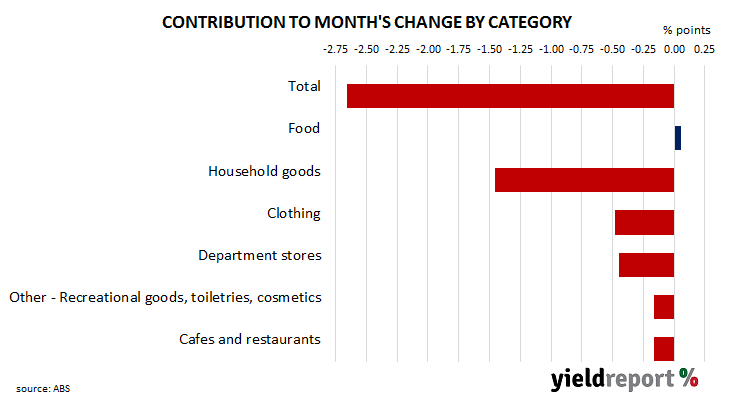Summary: Retail sales down 2.7% in December, worse than expected; up 0.8% on 12-month basis; ANZ: underlying trend in nominal retail sales looks weak; ACGB yields fall; rate-cut expectations firm a touch; ANZ: popularity of Black Friday sales changing spending patterns during end-of-year trading period; largest influence on result again from household goods sales.
Growth figures of domestic retail sales spent most of the 2010s at levels below the post-1992 average. While economic conditions had been generally favourable, wage growth and inflation rates were low. Expenditures on goods then jumped in the early stages of 2020 as government restrictions severely altered households’ spending habits. Households mostly reverted to their usual patterns as restrictions eased in the latter part of 2020 and throughout 2021.
According to the latest ABS figures, total retail sales slumped by 2.7% on a seasonally adjusted basis in December. The fall was a greater one than the 2.0% decrease which had been generally expected and in contrast with November’s downwardly revised 1.6% gain. Sales increased by 0.8% on an annual basis, down from November’s comparable figure of 2.2% after revisions.
“While the drop in sales had more to do with seasonal patterns not adjusted for in the data, the underlying trend in nominal retail sales looks weak,” said ANZ economist Madeline Dunk. “Q4 nominal retail sales grew just 0.5%, despite inflation and population growth.”
Commonwealth Government bond yields moved lower on the day, largely in line with movements of US Treasury yields overnight. By the close of business, the 3-year ACGB yield had lost 4bps to 3.69%, the 10-year yield had shed 7bps to 4.16% while the 20-year yield finished 8bps lower at 4.46%.
In the cash futures market, expectations regarding rate cuts later this year firmed a touch. At the end of the day, contracts implied the cash rate would remain close to the current rate for the next few months and average 4.325% through February, 4.315% in March and 4.295% in April. However, August contracts implied a 4.13% average cash rate while November contracts implied 3.965%, 35bps less than the current rate.
“There is no doubt the growing popularity of Black Friday sales is changing spending patterns during the end-of-year trading period,” Dunk added. “The December release included larger than usual revisions to the data, as the seasonal adjustment process attempts to capture this change in behaviour. Despite this, recent years have shown a consistent pattern of strong November growth followed by weak December results.”
Retail sales are typically segmented into six categories (see below), with the “Food” segment accounting for 40% of total sales. However, the largest influences on the month’s total once again came from the “Household goods” segment where sales fell by 8.5% over the month.



